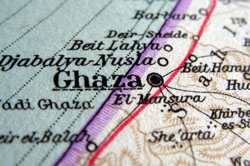The one-state solution
Monday, October 24, 2011

“Israel can be a Jewish country”: until Palestinians say these six words, both sides should stop pretending to negotiate
Every decade or so, two things happen in the Middle East.
First, someone proposes what is supposed to be a bold plan to end the Israeli-Palestinian conflict, by splitting the area into two states.
Second, the plan fails, and each side goes back to the job of trying to impose a one-state solution, in which it takes over the other side’s land.
In the latest pointless effort to find a two-state solution, Palestinians are asking the United Nations to admit their country as a member, so that they can have the prestige and authority they need, in order to negotiate seriously with Israel.
But Israel doesn’t care whether or not a Palestinian ambassador from time to time makes a speech in a drowsy auditoruim in New York.
In this case, the fact that Palestine becomes a member of the UN accomplishes nothing.
We have seen this pattern before.
In 1993, then-United States President Bill Clinton created a sensation by bringing together for the first time the leaders of Palestine and Israel, respectively, and getting them to endorse the Oslo two-state peace plan. Unfortunately, the plan fell apart soon after everyone finished their falafel.
Seven years later, the tireless Clinton did it again, this time getting Israel and Palestine to agree to the high-profile, Camp David two-state program.
But the program’s high ideals likewise disappeared, around the same time as the caterers.
The problem is that each side has its own version of the two-state plan.
For the Palestinians, the concept means - on one hand – their own republic, consisting of the West Bank plus Gaza, and - on the other hand - the State of Israel, more or less as it is today, but with many Palestinians living in it.
They are there because in this version of the plan, the children and grandchildren of Palestinians, who left Israel during the 1948 war of Israeli independence, have the right to go back.
But there are several million Palestinians who claim the right to return.
If many returned, they would likely outnumber Jews.
In this scenario, Israel exists as a separate country, but only until the next election, when a majority of voters, including millions of new citizens, elects a Palestinian government, which eliminates the border separating the two states.
Both are - after all - now run by the same group of people.
In its version of the two-state program, Israel agrees to pay compensation to Palestinians who lost their assets, instead of giving back the land, which they left over 60 years ago.
But Jews are not going to negotiate the end of the Jewish state.
In this situation there is - as usual - nothing for the two sides to talk about.
As long as there is no two-state solution, which includes a Jewish homeland, each side will try to impose its version of the one-state plan.
Many Palestinians anticipate the day when Middle Eastern nations join forces to create a Muslim army, which crushes the Zionist entity once and for all.
While they wait, Palestinians use unrelenting guerrilla tactics - cheap rockets and the occasional bomb - to show Israelis that they can never have peace in a Jewish nation.
For its part, Israel relies on advanced weapons, to discourage potential enemies from attacking.
In addition, Israel’s one-state program involves a combination of walls, security checkpoints and budget cuts, which makes it hard for Palestinians to work in the West Bank, to the extent that many move to other countries, leaving room for Jewish settlers.
History will decide which one-state concept was more effective.
Meanwhile, we can wait for the next bold, two-state solution, due in about ten years.
Fred Blaser
Chairman
Republica Media Group
